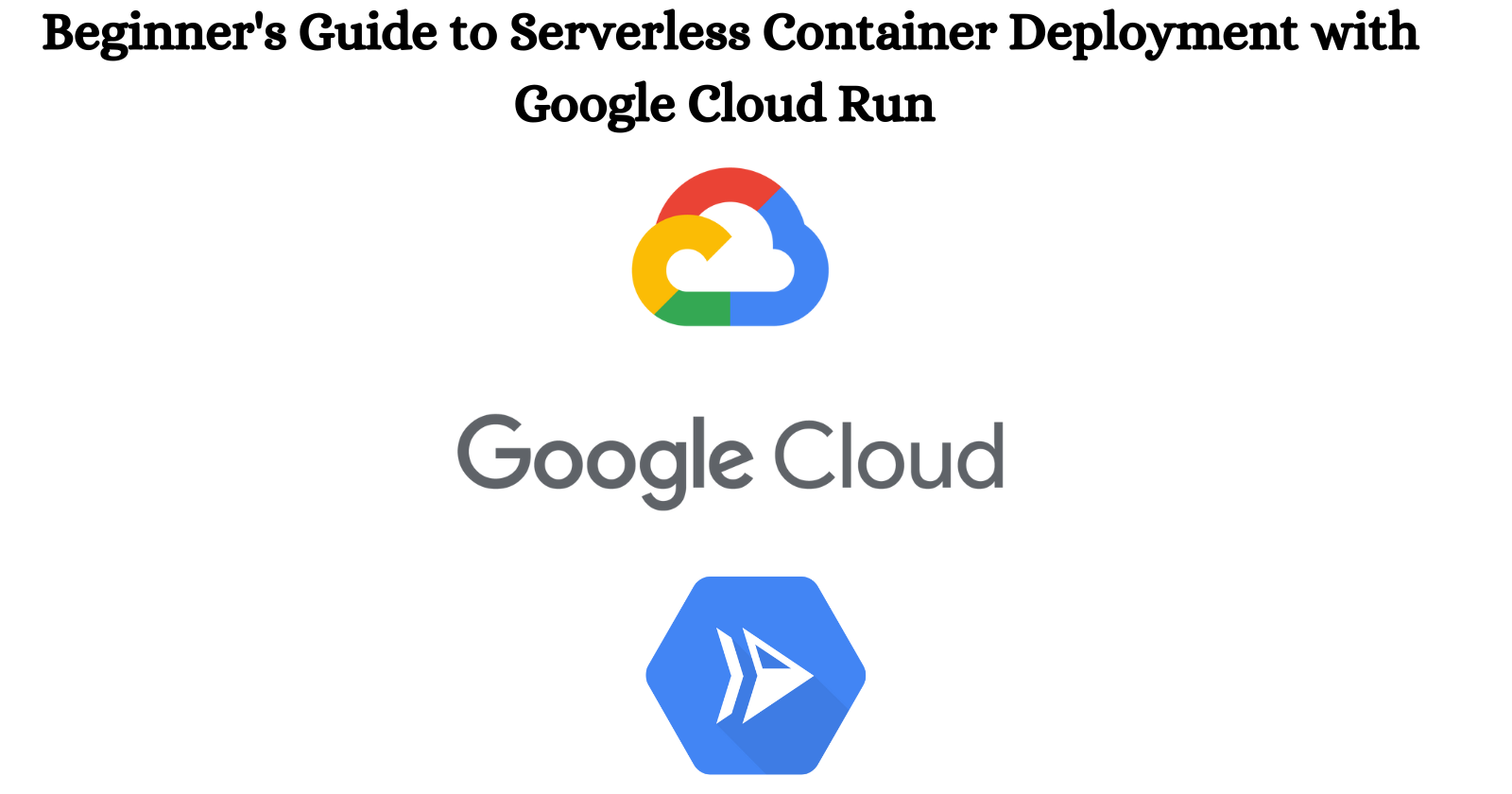Beginner's Guide to Serverless Container Deployment with Google Cloud Run
 Vishwas Sharma
Vishwas Sharma
Introduction: Google Cloud Run is an easy-to-use serverless platform that lets developers run apps in containers without worrying about infrastructure. This article will discuss its main features, advantages, and uses, as well as its structure and costs.
Overview of Google Cloud Run:
Google Cloud Run is a serverless compute platform designed for running containerized applications. It abstracts away the underlying infrastructure, allowing developers to focus on building and deploying applications without worrying about infrastructure management. With Cloud Run, developers can deploy their applications using popular container tools like Docker, taking advantage of the portability and scalability that containers provide.
Cloud Run offers two deployment options: Cloud Run (fully managed) and Cloud Run for Anthos (deploying on-premises or in other clouds using Anthos). The fully managed option provides a fully serverless experience, while Cloud Run for Anthos offers more flexibility for hybrid and multi-cloud deployments.
Key Features and Benefits:
a. Automatic Scaling: Google Cloud Run automatically scales the application instances based on incoming request traffic. It can handle sudden spikes in traffic by rapidly scaling up instances and scaling down during periods of low demand. This automatic scaling ensures efficient resource utilization and high availability.
b. Easy Deployment: With Cloud Run, developers can deploy their containerized applications using standard Docker containers. This makes it easy to package and deploy applications without worrying about the underlying infrastructure dependencies. Developers can also use popular container registries like Container Registry or Docker Hub for storing and managing their container images.
c. Stateless and Serverless: Each request sent to Cloud Run is processed in isolation, and the instances are stateless. This means that each request is independent of the others, allowing for horizontal scalability and fault tolerance. Cloud Run abstracts away the underlying server infrastructure, providing a true serverless experience.
d. Pay-per-Use Pricing: Google Cloud Run follows a pay-per-use pricing model. You only pay for the actual CPU and memory resources consumed during request processing. There are no upfront costs or minimum fees. This cost-effective pricing model allows you to scale your applications based on demand while optimizing costs.
Deep Dive into Architecture:
Google Cloud Run is built on top of Knative, an open-source Kubernetes-based platform for deploying serverless workloads. It leverages Kubernetes clusters and containerization technologies to provide a scalable and managed environment for running containers.
When someone asks for a Cloud Run service, the request goes to a free container that can manage it. Each container works in a separate space, away from others for safety and dependability. Containers are created and removed as needed, depending on traffic, making sure resources are used well and the system can grow.
Cloud Run also provides integration with Google Cloud Load Balancing, which distributes traffic across multiple instances and regions, improving availability and performance.
Integration with Google Cloud Ecosystem:
Google Cloud Run seamlessly integrates with other Google Cloud services, enabling developers to leverage a wide range of complementary services. For example:
Cloud Storage: Store and retrieve files or static assets used by your applications.
Cloud Pub/Sub: Build event-driven systems by subscribing to Pub/Sub topics and triggering actions in response to events.
Cloud Logging: Collect and analyze logs generated by your applications running on Cloud Run.
Cloud Monitoring: Monitor and gain insights into the performance and health of your Cloud Run services.
Additionally, Cloud Run can be easily integrated into continuous integration and delivery (CI/CD) pipelines using Google Cloud Build. This enables developers to automate the build, test, and deployment processes for their containerized applications.
Use Cases and Real-World Examples:
a. Microservices Architecture: Cloud Run is well-suited for deploying and scaling microservices-based applications. Each microservice can be deployed independently as a container, allowing for flexibility in development and scaling.
b. Webhooks and Event-Driven Processing: Cloud Run can process incoming events and trigger actions based on those events. It can be used to build webhook receivers, process data streams, or perform real-time data analysis.
c. Web Applications and APIs: Cloud Run can serve as a backend for web applications and APIs, handling variable traffic loads efficiently. It provides an ideal platform for running stateless HTTP-based services.
Tips for Optimizing and Monitoring Cloud Run Applications:
a. Optimizing Container Images: Follow best practices for creating optimized container images, such as minimizing image size, using appropriate base images, and optimizing dependencies.
b. Minimizing Startup Time: Reduce the startup time of your containers by optimizing the code, dependencies, and configurations. This ensures faster scaling and responsiveness.
c. Monitoring and Logging Strategies: Utilize Google Cloud Monitoring and Cloud Logging to gain insights into the performance, health, and logs of your Cloud Run services. Set up appropriate monitoring and alerting mechanisms to detect and resolve issues promptly.
Pricing and Cost Considerations:
Google Cloud Run pricing is based on the resources consumed during the request processing, including CPU and memory usage. Pricing varies depending on the deployment option (fully managed or Anthos) and the region where the service is deployed. Detailed pricing information can be found on the Google Cloud Run Pricing page.
Conclusion:
Google Cloud Run offers developers a powerful serverless platform for running containerized applications. It's automatic scaling, easy deployment, serverless architecture, and seamless integration with the Google Cloud ecosystem make it an attractive choice for a wide range of applications. By leveraging the benefits of Cloud Run, developers can focus on building and deploying applications with increased agility and reduced infrastructure management overhead.
References:
Google Cloud Run documentation: https://cloud.google.com/run/docs
"Introducing Google Cloud Run" by Google Cloud Blog: https://cloud.google.com/blog/products/serverless/introducing-google-cloud-run
"Serverless computing with Google Cloud Run" by Google Cloud Blog: https://cloud.google.com/blog/products/serverless/serverless-computing-with-google-cloud-run
"Getting started with Google Cloud Run" by Google Cloud documentation: https://cloud.google.com/run/docs/quickstarts/build-and-deploy
"Google Cloud Run: What it is and how to use it" by Cloud Academy: https://cloudacademy.com/blog/google-cloud-run-what-it-is-and-how-to-use-it/
"Google Cloud Run vs. Google App Engine: Serverless Showdown" by TechRepublic: https://www.techrepublic.com/article/google-cloud-run-vs-google-app-engine-serverless-showdown/
Subscribe to my newsletter
Read articles from Vishwas Sharma directly inside your inbox. Subscribe to the newsletter, and don't miss out.
Written by

Vishwas Sharma
Vishwas Sharma
Hello there! I'm Vishwas Sharma, a passionate Senior Cloud Administrator at Teradata. With a profound love for technology, I am constantly on the lookout for opportunities to expand my knowledge and stay up-to-date with the latest advancements in the industry. My expertise lies in Linux, GCP/AWS cloud, Docker, Kubernetes, and Terraform, and I find immense joy in exploring the vast potential of these technologies. Apart from my love for IT, I also make my own original Music. During my free time, I work for my own Youtube Channel named Vishwaas - Mujeeb Official. I write, produce and sing my original songs :)